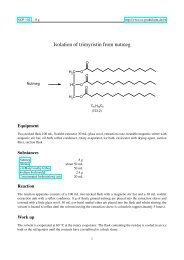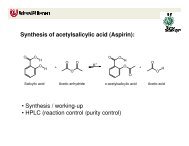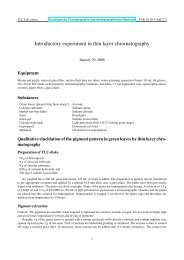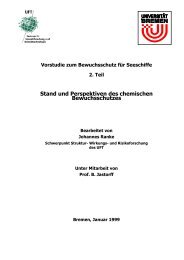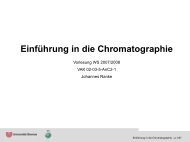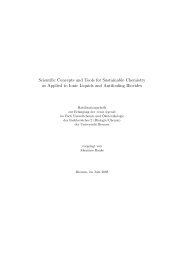Basic calibration functions for analytical chemistry
Basic calibration functions for analytical chemistry
Basic calibration functions for analytical chemistry
Create successful ePaper yourself
Turn your PDF publications into a flip-book with our unique Google optimized e-Paper software.
<strong>Basic</strong> <strong>calibration</strong> <strong>functions</strong> <strong>for</strong> <strong>analytical</strong><br />
<strong>chemistry</strong><br />
Johannes Ranke<br />
June 23, 2006<br />
The chemCal package was first designed in the course of a lecture and lab<br />
course on ”analytics of organic trace contaminants” at the University of Bremen<br />
from October to December 2004. In the fall 2005, an email exchange with Ron<br />
Wehrens led to the belief that it would be desirable to implement the inverse<br />
prediction method given in [1] since it also covers the case of weighted regression.<br />
Studies of the IUPAC orange book and of DIN 32645 as well as publications by<br />
Currie and the Analytical Method Committee of the Royal Society of Chemistry<br />
and a nice paper by Castillo and Castells provided further understanding of the<br />
matter.<br />
At the moment, the package consists of four <strong>functions</strong>, working on univariate<br />
linear models of class lm or rlm, plus to datasets <strong>for</strong> validation.<br />
A bug report (PR#8877) and the following e-mail exchange on the r-devel<br />
mailing list about prediction intervals from weighted regression entailed some<br />
further studies on this subject. However, I did not encounter any proof or explanation<br />
of the <strong>for</strong>mula cited below yet, so I can’t really confirm that Massart’s<br />
method is correct.<br />
When calibrating an <strong>analytical</strong> method, the first task is to generate a suitable<br />
model. If we want to use the chemCal <strong>functions</strong>, we will have to restrict ourselves<br />
to univariate, possibly weighted, linear regression so far.<br />
Once such a model has been created, the <strong>calibration</strong> can be graphically<br />
shown by using the calplot function:<br />
> library(chemCal)<br />
> data(massart97ex3)<br />
> m0 calplot(m0)<br />
1
Response<br />
0 20 40 60 80 100<br />
●<br />
Fitted Line<br />
Confidence Bands<br />
Prediction Bands<br />
●<br />
●<br />
●<br />
●<br />
●<br />
●<br />
●<br />
0 10 20 30 40 50<br />
Concentration<br />
As we can see, the scatter increases with increasing x. This is also illustrated<br />
by one of the diagnostic plots <strong>for</strong> linear models provided by R:<br />
> plot(m0, which = 3)<br />
2
Scale−Location<br />
●5 12●<br />
Standardized residuals<br />
0.0 0.5 1.0 1.5<br />
●<br />
●<br />
●<br />
●<br />
●<br />
●<br />
●<br />
●<br />
●<br />
●<br />
●<br />
●29<br />
●<br />
●<br />
●<br />
●<br />
●<br />
●<br />
●<br />
0 20 40 60 80 100<br />
Fitted values<br />
lm(y ~ x)<br />
There<strong>for</strong>e, in Example 8 in [1] weighted regression is proposed which can be<br />
reproduced by<br />
> attach(massart97ex3)<br />
> yx ybar s w weights m inverse.predict(m, 15, ws = 1.67)<br />
$Prediction<br />
[1] 5.865367<br />
$`Standard Error`<br />
[1] 0.892611<br />
$Confidence<br />
[1] 2.478285<br />
$`Confidence Limits`<br />
[1] 3.387082 8.343652<br />
3
inverse.predict(m, 90, ws = 0.145)<br />
$Prediction<br />
[1] 44.06025<br />
$`Standard Error`<br />
[1] 2.829162<br />
$Confidence<br />
[1] 7.855012<br />
$`Confidence Limits`<br />
[1] 36.20523 51.91526<br />
The weight ws assigned to the measured y value has to be given by the user<br />
in the case of weighted regression, or alternatively, the approximate variance<br />
var.s at this location.<br />
Theory <strong>for</strong> inverse.predict<br />
Equation 8.28 in [1] gives a general equation <strong>for</strong> predicting the standard error<br />
s ˆxs <strong>for</strong> an x value predicted from measurements of y according to the linear<br />
<strong>calibration</strong> function y = b 0 + b 1 · x:<br />
with<br />
s ˆxs<br />
= s e<br />
b 1<br />
√ √√√<br />
1<br />
w s m + 1 ∑<br />
wi<br />
+<br />
s e =<br />
(ȳ s − y¯<br />
w ) ∑ 2 w i<br />
(<br />
2<br />
∑ ∑<br />
b 1 wi wi x i2 − ( ∑ (1)<br />
2)<br />
w i x i )<br />
√∑<br />
wi (y i − ŷ i ) 2<br />
n − 2<br />
where w i is the weight <strong>for</strong> <strong>calibration</strong> standard i, y i is the mean y value<br />
(!) observed <strong>for</strong> standard i, ŷ i is the estimated value <strong>for</strong> standard i, n is the<br />
number <strong>calibration</strong> standards, w s is the weight attributed to the sample s, m<br />
is the number of replicate measurements of sample s, ȳ s is the mean response<br />
<strong>for</strong> the sample, y¯<br />
w =<br />
∑<br />
wiy i<br />
∑<br />
wi<br />
(2)<br />
is the weighted mean of responses y i , and x i is the<br />
given x value <strong>for</strong> standard i.<br />
The weight w s <strong>for</strong> the sample should be estimated or calculated in accordance<br />
to the weights used in the linear regression.<br />
I adjusted the above equation in order to be able to take a different precisions<br />
in standards and samples into account. In analogy to Equation 8.26 from [1] we<br />
get<br />
√ √√√√ ⎛<br />
s ˆxs = 1 s<br />
2 s<br />
b 1 w s m + s e 2 ⎝∑ 1<br />
(ȳ s − y¯<br />
w ) ∑ ⎞<br />
+ ( 2 w i<br />
wi 2<br />
∑ ∑<br />
b 1 wi wi x i2 − ( ∑ w i x i ) 2) ⎠ (3)<br />
4
where I interpret ss2<br />
w s<br />
as an estimator of the variance at location ˆx s , which can<br />
be replaced by a user-specified value using the argument var.s of the function<br />
inverse.predict.<br />
References<br />
[1] Massart, L.M, Vandenginste, B.G.M., Buydens, L.M.C., De Jong, S., Lewi,<br />
P.J., Smeyers-Verbeke, J. Handbook of Chemometrics and Qualimetrics:<br />
Part A, Elsevier, Amsterdam, 1997<br />
5



